Last updated: July 18, 2023
Article
Wildfires Kill Unprecedented Numbers of Large Sequoia Trees

NPS / Anthony Caprio
Six Fires in Six Years (2015-2021)
Six fires, occurring between 2015 and 2021 killed many large sequoias in numerous groves across the Sierra Nevada (Figure 1). More than 85 percent of all giant sequoia grove acreage across the Sierra Nevada has burned in wildfires between 2015 and 2021, compared to only one quarter in the preceding century. Three of these fires burned into Sequoia and Kings Canyon National Parks. Note that estimated numbers of dead large sequoias may increase, as fire-related mortality can continue for years after a fire.
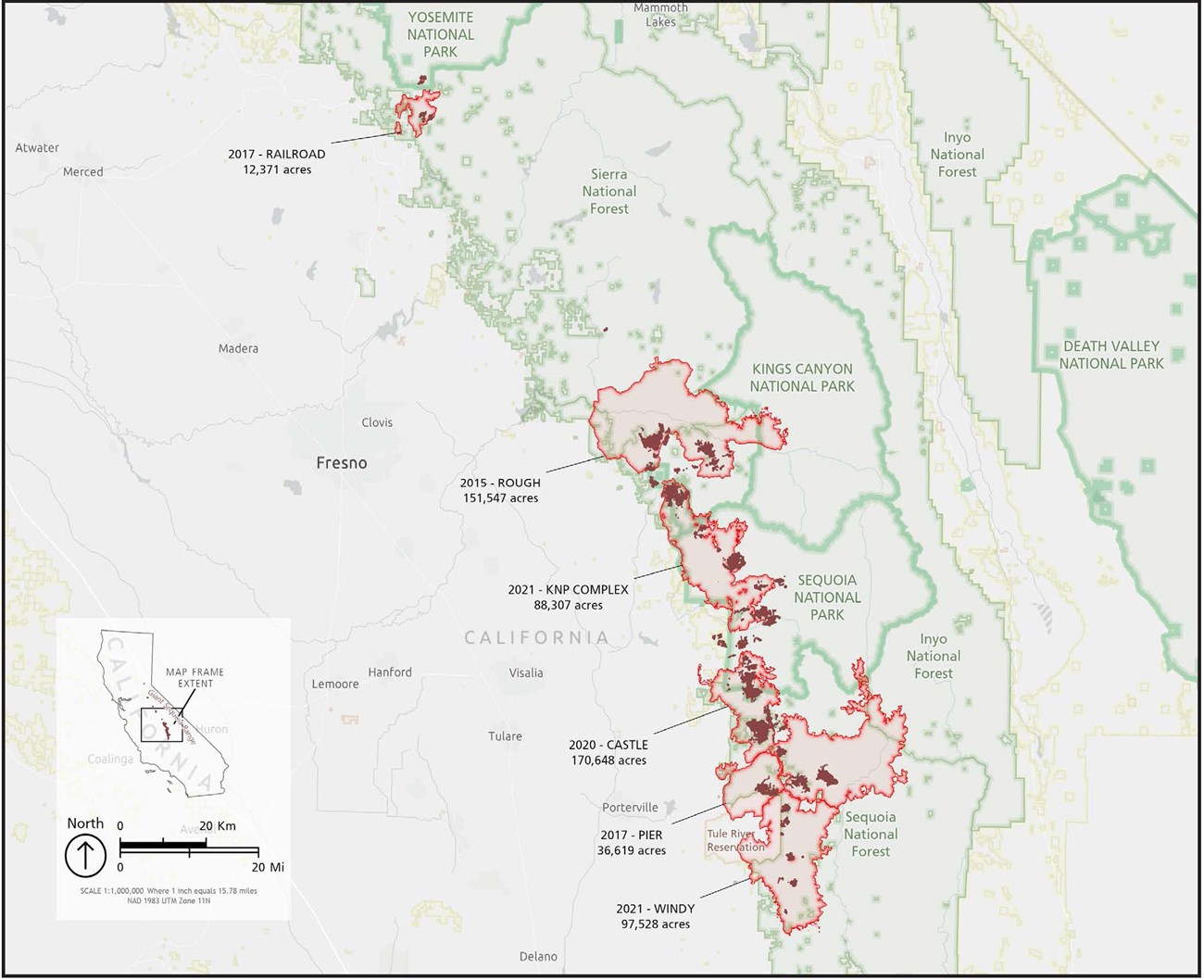
NPS / Joshua Flickinger
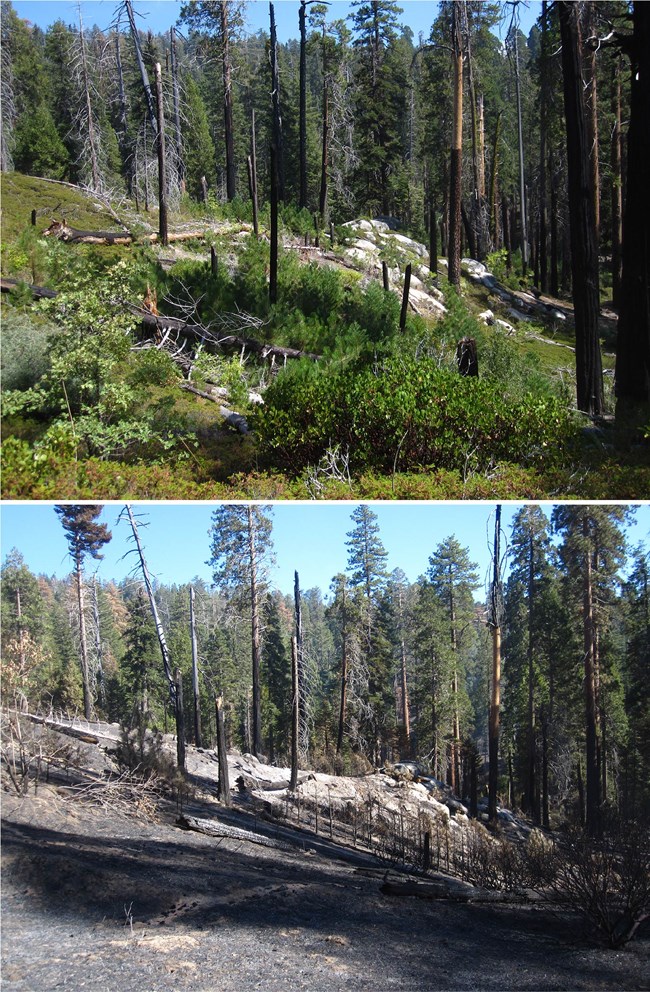
NPS / Anthony Caprio
2015 Rough Fire
Lightning started the Rough Fire in July 2015 in a steep, rugged area of the Kings Canyon in Sierra National Forest. It burned into seven different sequoia groves or grove complexes in Sequoia National Monument (USFS) and into the General Grant Grove, which includes old-growth sequoias in Kings Canyon National Park and second-growth sequoias (established after logging) in Sequoia National Forest. While most of the groves burned at low to moderate severity, about 5 percent of grove area burned at high severity.
Fortunately, the majority of the Grant Grove area burned by the Rough Fire in Kings Canyon National Park had already been burned 2-3 times by prescribed fires. In these areas, effects from the Rough Fire were low severity and patchy, with large unburned areas remaining. However, areas near the park boundary that were outside of the prescribed burn boundaries burned with much higher severity. A total of 27 large sequoias were killed on park land in Grant Grove. In U.S Forest Service groves, at least 74 fire-killed large sequoias were documented.
2017 Pier and Railroad Fires
Both of these fires were reported on August 29, 2017. The human-caused Pier Fire started in the Tule River Canyon, north of Springville, California and burned into Sequoia National Monument (USFS). The Pier Fire killed at least 72 large giant sequoias in the Black Mountain Grove, and 31 of these were greater than 10 feet in diameter. The Railroad Fire started west of Highway 41 near the small community of Sugar Pine, south of Yosemite National Park. It burned into the Nelder Grove of giant sequoias in Sierra National Forest and killed at least 38 large giant sequoias.

NPS / Anthony Caprio, taken from a helicopter flight on November 2, 2020.
2020 Castle Fire
Lightning started the Castle Fire on August 19, 2020 in a remote area of Sequoia National Forest, southeast of Sequoia National Park. By the time the fire was contained in December, it had burned 171,000 acres, including over 9,530 acres of giant sequoia groves on U.S. Forest Service, National Park Service, State of California, Tulare County, and private lands. This represents one-third of all sequoia grove area across the Sierra Nevada, the only area in the world where giant sequoias occur naturally.
Unprecedented Numbers of Large Sequoias Killed
The Castle Fire killed an estimated 7,500 to 10,600 large sequoias (those with trunk diameters of 4 feet or more ,or >1.2 meters). This is 31 to 42 percent of large sequoias within the Castle Fire, or 10 to 14 percent of all large sequoias across the tree's natural range in the Sierra Nevada (Stephenson and Brigham DRAFT in press).
Castle Fire Had Varied Impacts on Sequoia Groves
Using maps of giant sequoia groves and burn severity data (effects of fire on vegetation and soil, inferred from satellite images), local scientists have estimated how much sequoia grove area burned at low, moderate, or high severity. They estimated about half burned at low severity or had no detectable change, and about half burned at moderate or high severity. Nearly 30 percent of grove area within the Castle Fire burned at high severity (Stephenson and Brigham DRAFT in press). Figure 1 is a map of fire severity levels across the Castle Fire, particularly emphasizing fire severity in sequoia groves.

NPS / Joshua Flickinger
High Severity Fire
Within Sequoia National Park, three grove areas experienced high severity fire: Upper Dillonwood, Homer's Nose, and Board Camp. An estimated 369 large giant sequoias were killed in areas that burned at high severity in these groves. Various factors contributed to fire behavior that killed many large trees. They were all areas that had not burned in many decades, so had larger amounts of ground fuels like logs and fallen dead branches. These groves occurred on steep, south-facing slopes where warmer, drier conditions favored more severe fire.
Preliminary field assessments of Board Camp and Upper Dillonwood indicate that most giant sequoias died in the high severity fire areas, and only minimal seedling establishment has been observed. Typically, a fire increases seed dispersal from giant sequoia cones, as the heat opens them and releases seeds. After woody fuels on the forest floor burn, conditions are better for the small giant sequoia seeds to get established. But in these severe fires, it appears that the cones burned, even though they are usually high up in the tree canopy above the height where flames typically reach.
To get a sense of what it's like to walk into a sequoia grove and be surrounded by dead trees, see the photo below.
Other groves on U.S. Forest Service, State, County, or private lands also experienced high-severity fire. Some of these were extensive groves where thousands of large giant sequoias died in the fire. While these sequoia groves are outside the park and not discussed in-depth here, the large sequoias that died in all burned groves are included in the Unprecedented Numbers of Large Sequoias Killed estimates above.
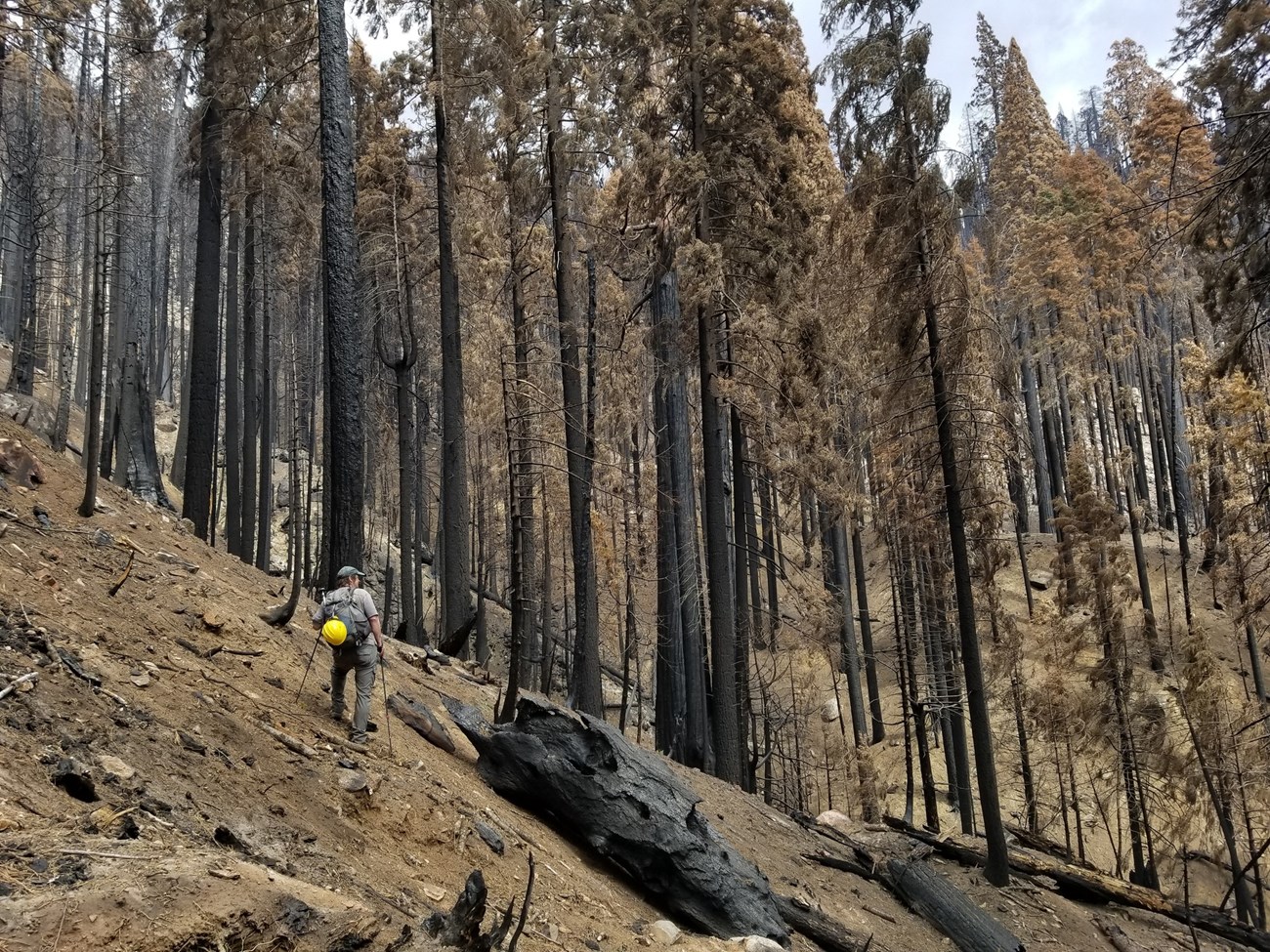
NPS / Anthony Caprio
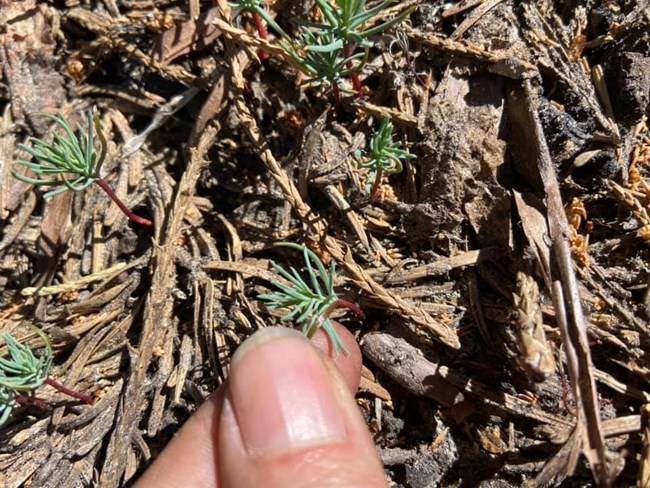
NPS / Christy Brigham
Low or Moderate Severity Fire
Historically, low to moderate severity fire burned every 6 to 35 years in giant sequoia groves. Shrubs and smaller trees were killed in some areas, and occasional patches of higher severity fire created gaps in the canopy where seedlings could take root and grow. Park staff are still assessing fire effects in groves burned by the Castle Fire. Based on other recent fires, however, scientists estimate that of all the large sequoias in the Castle Fire, less than 10 percent may have died due to low severity fire and about 34 percent may have died in moderate severity fire areas (Stephenson and Brigham DRAFT in press). Actual ground surveys are underway and will help us more accurately evaluate fire effects in these groves.
Groves that burned with low to moderate severity fire typically occurred on north-facing, more moist slopes. Examples include Garfield and South Fork groves. Garfield also had more recent fire history, including a 1985 prescribed burn. Initial on-the-ground surveys at Garfield Grove have documented giant sequoia seedlings establishing. On-going surveys are assessing fire effects on giant sequoias and ground fuels across areas with different site characteristics (such as slope steepness and direction the slope faces). It will also be important to assess mortality in the years following the fire as delayed mortality can occur related to fire-related injuries and bark beetle infestations. Beetle damage has been newly documented as contributing to giant sequoia death (Stephenson et al. in prep).
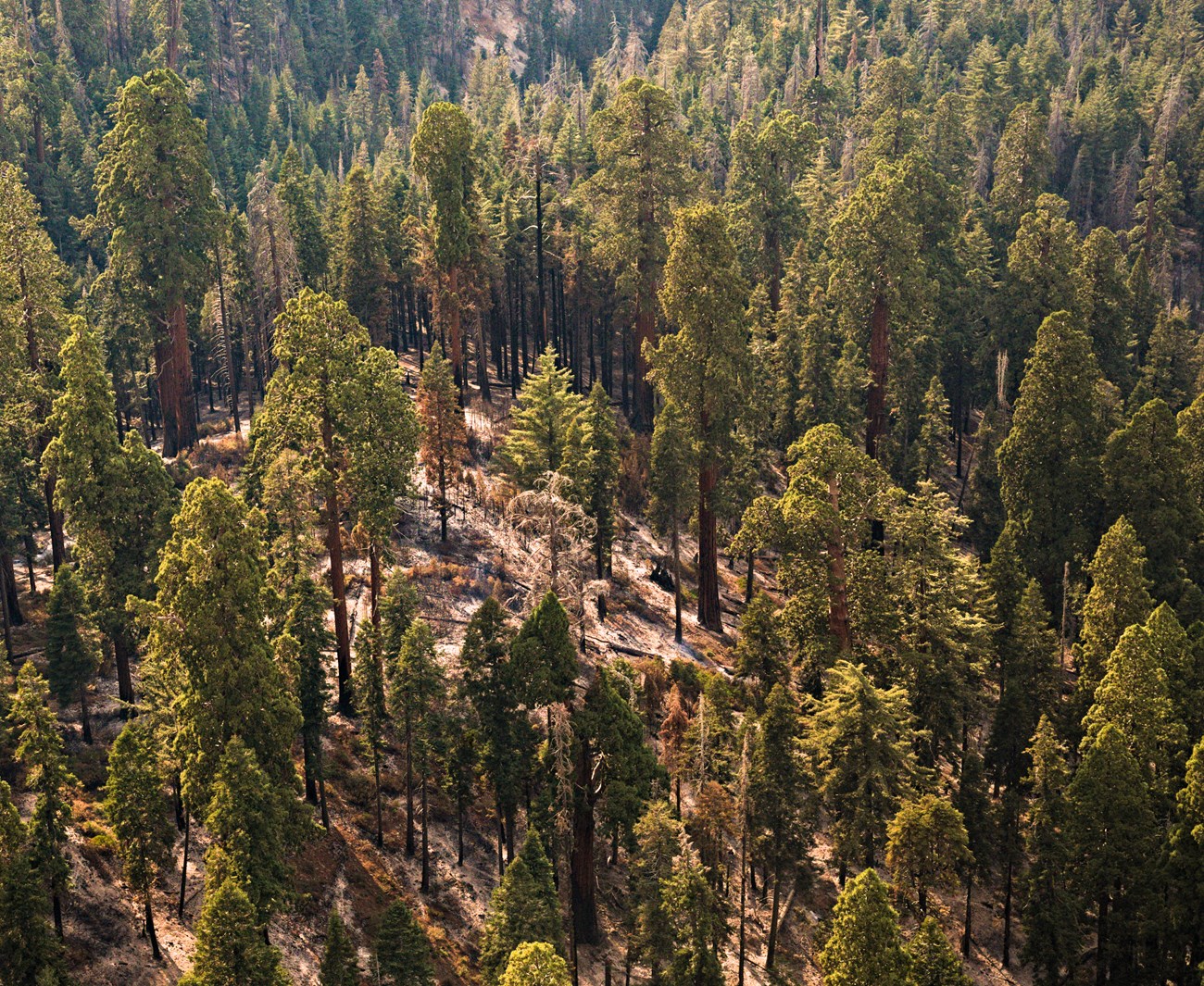
NPS / Anthony Caprio. Photo taken on November 2, 2020 from a helicopter flight over the Castle Fire.

NPS / Tony Caprio. Photos taken during a helicopter flight surveying burned groves in the KNP Complex Fire on October 12, 2021.
2021 KNP Complex and Windy Fires
KNP Complex
Lightning ignited three fires in Sequoia National Park on September 9, 2021. One fire was contained quickly, but the Colony and Paradise fires burned in extremely steep terrain with lack of trail or road access, and the high density of drought-killed dead trees presented risks to firefighters.These access and safety issues challenged fire-fighting efforts. By September 17, these fires merged, becoming the KNP Complex. The fire was fully contained on December 16 at 88,307 acres, after storms brought substantial rain and snow.
This fire burned 16 sequoia groves (almost entirely on NPS lands, with the exception of parts of Redwood Mountain Grove). Fire severity was estimated based on satellite data and sequoia grove maps. Of the 4,374 grove acres burned, 69 percent of the area had either no detected change or low severity fire, while 31 percent burned at moderate to high severity. Scientists estimate that between 1,330 to 2,380 large sequoias (over 4 feet or 1.2 meters in diameter) have already been killed or will die within the next 3 to 5 years.
Learn more about this fire's timeline and management on Sequoia and Kings Canyon National Parks' KNP Complex Fire web page.
Windy
The September 9th lightning storm that ignited the KNP Complex fires also started the Windy Fire, located south of Sequoia National Park in Sequoia National Forest and the Tule River Reservation. It burned 97,528 acres by a containment date of November 15, 2021. Scientists estimate that between 931 to 1,257 large sequoias were killed or will die in the next 3-5 years.
Taken together, the combined loss from the KNP Complex and Windy fires is estimated to be 2,261 to 3,637 large sequoias that have already been killed or will die in the next three to five years, or 3 to 5 percent of the sequoias in the entire Sierra Nevada population of large sequoias.

NPS / Christy Brigham
Now is the time for action.
The unprecedented number of giant sequoias lost to fire last year serves as a call to action. We know that climate change is increasing the length and severity of our fire seasons due to hotter temperatures and drought. To combat these emerging threats to our forests, we must come together across agencies. Actions that are good for protecting our forests are also good for protecting our communities.
--Clay Jordan, Superintendent, Sequoia and Kings Canyon National Parks, July 2021
Managers of lands where giant sequoias occur recognize the importance of working across management boundaries, with each other and numerous other partners, to protect giant sequoias in the face of emerging threats: a warming climate, severe fire, drought, and beetles. The Giant Sequoia Lands Coalition has been formed with an eye toward the future, to better enable land managers to protect the remaining giant sequoias. It comprises all public and Tribal land management agencies in stewardship of giant sequoias. The members of the Giant Sequoia Lands Coalition are:
- National Park Service, represented by Sequoia and Kings Canyon National Parks and Yosemite National Park
- United States Forest Service, represented by Sequoia National Forest and Giant Sequoia National Monument, Sierra National Forest, and Tahoe National Forest
- Bureau of Land Management, represented by Case Mountain Extensive Recreation Management Area
- Tule River Indian Tribe, stewards of Black Mountain Grove
- State of California, represented by Calaveras Big Trees State Park and Mountain Home Demonstration State Forest
- University of California, Berkeley, stewards of Whitaker’s Research Forest
- Tulare County, stewards of Balch Park
These organizations and additional partners (such as U.S. Geological Survey Western Ecological Research Center, Sequoia Parks Conservancy, and Save the Redwoods League) have the following goals:
- Increase wildfire resilience through research and monitoring
- Increase pace and scale of forest treatments to reduce forest fuels through prescribed burning and restorative thinning
- Increase efficiency through partnerships aimed at policy changes that allow for more swift action
For more information and resources about emerging threats to giant sequoias, visit the Giant Sequoia Lands Coaltion web page.
References
Stephenson, N. and. and C. Brigham. 2021. Preliminary estimates of sequoia mortality in the 2020 Castle Fire (web article).Stephenson, N. L. 2000. Estimated ages of some large giant sequoias: General Sherman keeps getting younger. Madroño 47, no. 1 (2000): 61-67.
Stephenson et al. in prep. Giant sequoias [apparently] killed by novel interactions of extreme drought, recent fire, and bark beetle.
